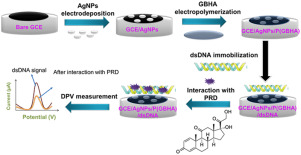Bioelectrochemistry ( IF 5 ) Pub Date : 2018-11-16 , DOI: 10.1016/j.bioelechem.2018.11.003 Gözde Aydoğdu Tığ , Derya Koyuncu Zeybek , Bülent Zeybek , Şule Pekyardımcı

|
This paper reports the fabrication of an electrochemical DNA biosensor for the electrochemical determination of prednisone (PRD), which is a synthetic corticosteroid. For this purpose, silver nanoparticles (AgNPs) and a new polymer film poly(glyoxal-bis(2-hydroxyanil)) (P(GBHA)) were electrochemically deposited on a glassy carbon electrode (GCE), respectively. Then, an electrochemical DNA biosensor was prepared onto this electrode surface (GCE/AgNPs/P(GBHA)) by the immobilization of dsDNA using a chronoamperometry method. The proposed electrode was characterized by FESEM, XPS, and cyclic voltammetry (CV). The interaction between the PRD and dsDNA immobilized on the GCE/AgNPs/P(GBHA) electrode was investigated via a differential pulse voltammetry (DPV) method and UV–Vis spectrophotometry. The experimental factors affecting the interaction between the PRD concentration and dsDNA were optimized. The fabricated biosensor showed a wide linear response in a PRD concentration range of 1.0–50.0 μg mL−1 depending on both the adenine and guanine base signals. The detection limit based on the guanine and adenine signals was 0.3 μg mL−1 and 0.25 μg mL−1, respectively. The sensor exhibited excellent anti-interferential ability, good stability and reproducibility and was satisfactorily employed for the electrochemical assay of PRD in serum samples. The new DNA biosensor can be utilized for the sensitive, accurate and rapid analysis of PRD.
中文翻译:

泼尼松与dsDNA在银纳米颗粒/聚乙二醛-双(2-羟基茴香)/ dsDNA修饰电极上的相互作用及其分析应用
本文报道了用于电化学测定泼尼松(PRD)的电化学DNA生物传感器的制备,这是一种合成的皮质类固醇。为此,分别在玻璃碳电极(GCE)上电化学沉积了银纳米颗粒(AgNPs)和新的聚合物薄膜聚乙二醛-双(2-羟基茴香醚)(P(GBHA))。然后,通过使用计时电流法将dsDNA固定化,在该电极表面(GCE / AgNPs / P(GBHA))上制备了电化学DNA生物传感器。建议的电极通过FESEM,XPS和循环伏安法(CV)进行表征。通过微分脉冲伏安法(DPV)和紫外可见分光光度法研究了PRD和固定在GCE / AgNPs / P(GBHA)电极上的dsDNA之间的相互作用。优化了影响PRD浓度与dsDNA相互作用的实验因素。制成的生物传感器在1.0-50.0μgmL的PRD浓度范围内显示出宽线性响应-1取决于腺嘌呤和鸟嘌呤碱基信号。基于鸟嘌呤和腺嘌呤信号的检测极限分别为0.3μgmL -1和0.25μgmL -1。该传感器显示出优异的抗干扰能力,良好的稳定性和可重复性,并被令人满意地用于血清样品中PRD的电化学分析。新型DNA生物传感器可用于对PRD进行灵敏,准确和快速的分析。



























 京公网安备 11010802027423号
京公网安备 11010802027423号